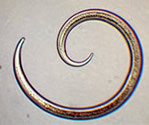Plant Diseases and Insect Pests
Plant Identification and Plant Disease Identification
Plant identification is critical for Integrated Pest Management (IPM) and the proper use of pesticides in agriculture and horticulture situations. It is also helpful to the clientele that just want information on that weed, flower, shrub or tree growing in their landscape.
Disease organisms such as fungi, bacteria, and viruses can damage and/or kill a wide variety of plant materials in Georgia. It is essential to identify the organism accurately before implementing co
ntrol strategies.
Tips for Submitting Plant Specimens

** Do people call you and ask, "What's that black thing on my rose bush?". These tips might save some phone calls and emails with those people.
Can you think of other things that your office continually spends time explaining? Or things that come up over and again? It might be a good idea to put that information on the website! **
When possible, collect a generous sample of the plant's stem with leaves still attached. Try to include any flowers, fruits, cones or buds of the plant.
Deliver the specimen fresh to the county Extension Office. Plant samples may not be identifiable if they have been crushed, decayed or dried and shriveled.
To assist in obtaining a rapid, accurate identification of plant specimens, be sure to bring the following information:
Insect Identification
Proper diagnosis is necessary to achieve good pest management. It's important to remember that only a small percentage of insects on plants are pests.
Nematode Testing
Nematodes cause roots to become knotted and galled and impair the root system so that water and nutrients cannot be taken up. Nematode damaged plants become stunted, turn yellow and wilt in hot weather.
The best time to determine if you have a nematode problem is in the summer and fall, when nematodes are most numerous.
